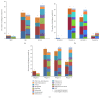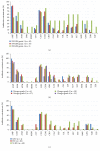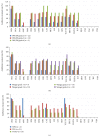Bacterial Profile and Antibiotic Resistance in Patients with Diabetic Foot Ulcer in Guangzhou, Southern China: Focus on the Differences among Different Wagner's Grades, IDSA/IWGDF Grades, and Ulcer Types
- PMID: 29075293
- PMCID: PMC5623783
- DOI: 10.1155/2017/8694903
Bacterial Profile and Antibiotic Resistance in Patients with Diabetic Foot Ulcer in Guangzhou, Southern China: Focus on the Differences among Different Wagner's Grades, IDSA/IWGDF Grades, and Ulcer Types
Abstract
Objective: To understand the bacterial profile and antibiotic resistance patterns in diabetic foot infection (DFI) in different Wagner's grades, IDSA/IWGDF grades, and different ulcer types in Guangzhou, in order to provide more detailed suggestion to the clinician about the empirical antibiotic choice.
Methods: 207 bacteria were collected from 117 DFIs in Sun Yat-sen Memorial Hospital from Jan.1, 2010, to Dec.31, 2015. The clinical data and microbial information were analyzed.
Results: The proportion of Gram-negative bacteria (GNB) was higher than Gram-positive bacteria (GPB) (54.1% versus 45.9%), in which Enterobacteriaceae (73.2%) and Staphylococcus (65.2%) were predominant, respectively. With an increasing of Wagner's grades and IDSA/IWGDF grades, the proportion of GNB bacterial infection, especially Pseudomonas, was increased. Neuro-ischemic ulcer (N-IFU) was more susceptible to GNB infection. Furthermore, with the aggravation of the wound and infection, the antibiotic resistance rates were obviously increased. GPB isolated in ischemic foot ulcer (IFU) showed more resistance than the N-IFU, while GNB isolates were on the opposite.
Conclusions: Different bacterial profiles and antibiotic sensitivity were found in different DFU grades and types. Clinician should try to stay updated in antibiotic resistance pattern of common pathogens in their area. This paper provided them the detailed information in this region.
Figures




Similar articles
-
Microbial profile, antimicrobial resistance, and molecular characterization of diabetic foot infections in a university hospital.Germs. 2021 Mar 15;11(1):39-51. doi: 10.18683/germs.2021.1239. eCollection 2021 Mar. Germs. 2021. PMID: 33898340 Free PMC article.
-
Microbial Profile and Antibiotic Susceptibility Pattern in Diabetic Patients with Mild, Moderate, and Severe Foot Infections in Tehran.Arch Razi Inst. 2022 Oct 31;77(5):1925-1933. doi: 10.22092/ARI.2022.359759.2476. eCollection 2022 Oct. Arch Razi Inst. 2022. PMID: 37123144 Free PMC article.
-
Distribution of Microbes and Drug Susceptibility in Patients with Diabetic Foot Infections in Southwest China.J Diabetes Res. 2018 Aug 5;2018:9817308. doi: 10.1155/2018/9817308. eCollection 2018. J Diabetes Res. 2018. PMID: 30175153 Free PMC article.
-
Microbiological Distribution, Antimicrobial Susceptibility and Risk Factors of Polymicrobial Infections in Diabetic Foot.Clin Lab. 2024 Apr 1;70(4). doi: 10.7754/Clin.Lab.2023.231114. Clin Lab. 2024. PMID: 38623675
-
Diabetic foot ulcer in Southern Jordan: A cross-sectional Study of Clinical and Microbiological Aspects.Ann Med Surg (Lond). 2022 Apr 2;76:103552. doi: 10.1016/j.amsu.2022.103552. eCollection 2022 Apr. Ann Med Surg (Lond). 2022. PMID: 35495384 Free PMC article.
Cited by
-
Enhancing diabetic foot ulcer healing: Impact of the regulation of the FUS and ILF2 RNA‑binding proteins through negative pressure wound therapy.Int J Mol Med. 2024 Nov;54(5):103. doi: 10.3892/ijmm.2024.5427. Epub 2024 Sep 20. Int J Mol Med. 2024. PMID: 39301661 Free PMC article.
-
Bacteriological Profile and Antibiotic Susceptibility in Patients With Diabetic Foot Infections.Cureus. 2025 Apr 22;17(4):e82809. doi: 10.7759/cureus.82809. eCollection 2025 Apr. Cureus. 2025. PMID: 40416133 Free PMC article.
-
Bacteriological analysis and antibiotic resistance in patients with diabetic foot ulcers in Dhaka.PLoS One. 2024 May 17;19(5):e0301767. doi: 10.1371/journal.pone.0301767. eCollection 2024. PLoS One. 2024. PMID: 38758936 Free PMC article.
-
Advanced Glycation End Products Enhance Biofilm Formation by Promoting Extracellular DNA Release Through sigB Upregulation in Staphylococcus aureus.Front Microbiol. 2020 Jul 14;11:1479. doi: 10.3389/fmicb.2020.01479. eCollection 2020. Front Microbiol. 2020. PMID: 32765439 Free PMC article.
-
The Role of Novel Antibiotics in the Management of Diabetic Foot Infection.Diabetes Ther. 2023 Feb;14(2):251-263. doi: 10.1007/s13300-022-01357-2. Epub 2022 Dec 24. Diabetes Ther. 2023. PMID: 36565422 Free PMC article. Review.
References
LinkOut - more resources
Full Text Sources
Other Literature Sources
Research Materials

